fuel pressure MAZDA MODEL 6 2017 Owners Manual (in English)
[x] Cancel search | Manufacturer: MAZDA, Model Year: 2017, Model line: MODEL 6, Model: MAZDA MODEL 6 2017Pages: 578, PDF Size: 54.72 MB
Page 102 of 578
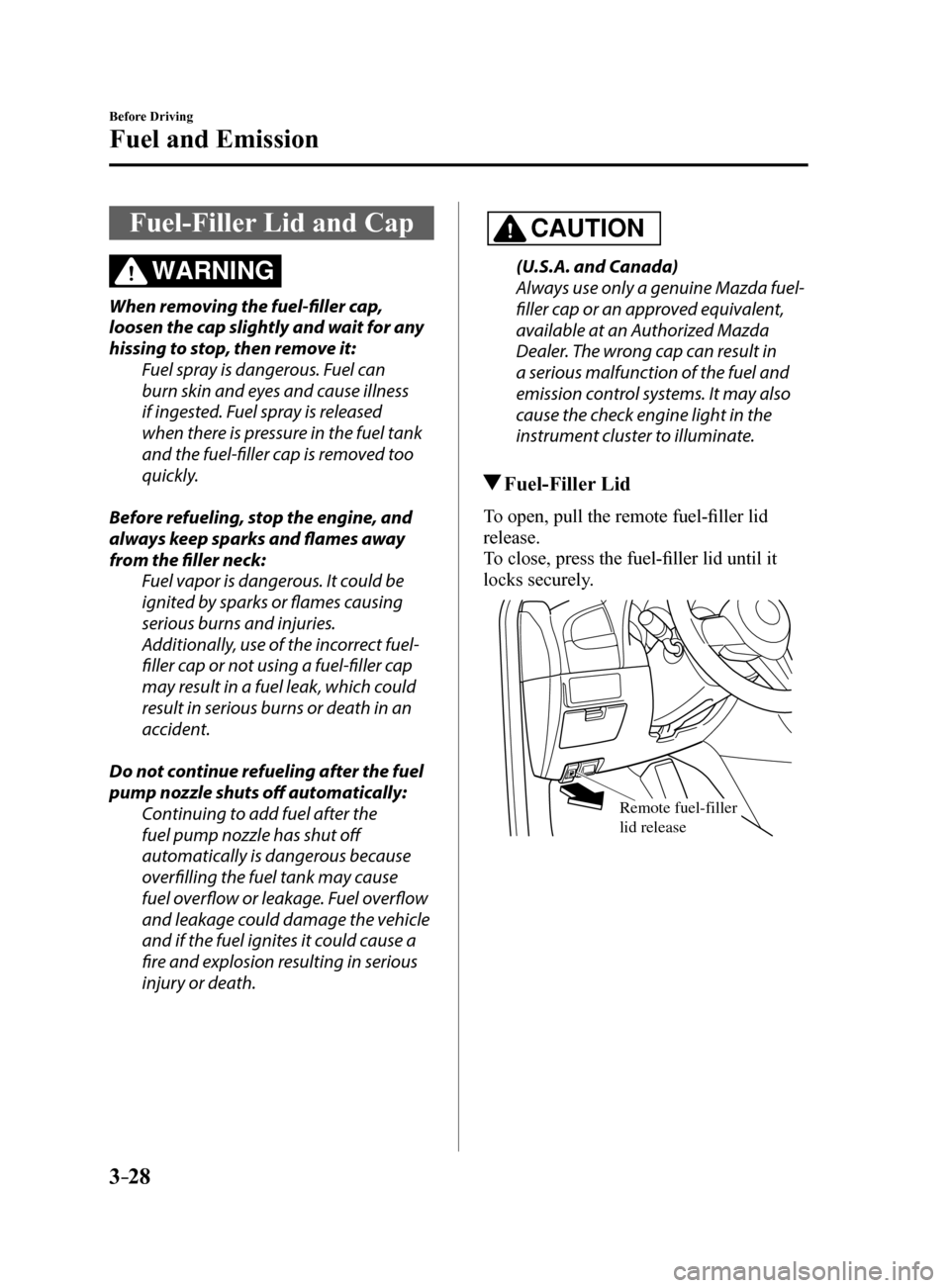
3–28
Before Driving
Fuel and Emission
Fuel-Filler Lid and Cap
WARNING
When removing the fuel-filler cap,
loosen the cap slightly and wait for any
hissing to stop, then remove it:Fuel spray is dangerous. Fuel can
burn skin and eyes and cause illness
if ingested. Fuel spray is released
when there is pressure in the fuel tank
and the fuel-filler cap is removed too
quickly.
Before refueling, stop the engine, and
always keep sparks and flames away
from the filler neck: Fuel vapor is dangerous. It could be
ignited by sparks or flames causing
serious burns and injuries.
Additionally, use of the incorrect fuel-
filler cap or not using a fuel-filler cap
may result in a fuel leak, which could
result in serious burns or death in an
accident.
Do not continue refueling after the fuel
pump nozzle shuts off automatically: Continuing to add fuel after the
fuel pump nozzle has shut off
automatically is dangerous because
overfilling the fuel tank may cause
fuel overflow or leakage. Fuel overflow
and leakage could damage the vehicle
and if the fuel ignites it could cause a
fire and explosion resulting in serious
injury or death.
CAUTION
(U.S.A. and Canada)
Always use only a genuine Mazda fuel-
filler cap or an approved equivalent,
available at an Authorized Mazda
Dealer. The wrong cap can result in
a serious malfunction of the fuel and
emission control systems. It may also
cause the check engine light in the
instrument cluster to illuminate.
Fuel-Filler Lid
To open, pull the remote fuel-filler lid
release.
To close, press the fuel-filler lid until it
locks securely.
Remote fuel-filler lid release
Mazda6_8FH2-EA-16F_Edition2.indb 282016/07/07 13:44:27
Page 126 of 578

4–2
*Some models.
Fuel Economy Monitor .....................4-83
Fuel Economy Monitor ................ 4-83
Drive Selection ................................... 4-86
Drive Selection
* ........................... 4-86
Power Steering ................................... 4-87
Power Steering ............................. 4-87
i-ACTIVSENSE ................................. 4-88
i-ACTIVSENSE
*.......................... 4-88
Adaptive Front Lighting System
(AFS)
* .......................................... 4-90
High Beam Control System
(HBC)*.......................................... 4-91
Blind Spot Monitoring (BSM)* .... 4-94
Traffic Sign Recognition System
(TSR)
* ........................................ 4-100
Distance Recognition Support System
(DRSS)
* ...................................... 4-107
Rear Cross Traffic Alert
(RCTA)* ..................................... 4-111
Mazda Radar Cruise Control
(MRCC)* .................................... 4-115
Lane-keep Assist System (LAS) &
Lane Departure Warning System
(LDWS)
* .................................... 4-125
Smart City Brake Support
(SCBS)* ...................................... 4-138
Smart Brake Support (SBS)* ...... 4-143
Forward Sensing Camera
(FSC)* ......................................... 4-146
Radar Sensor (Front)* ................. 4-150
Radar Sensors (Rear)* ................ 4-153 Cruise Control .................................
4-155
Cruise Control
* ........................... 4-155
Tire Pressure Monitoring System ...4-159
Tire Pressure Monitoring
System ........................................ 4-159
Rear View Monitor ..........................4-163
Rear View Monitor ..................... 4-163
Mazda6_8FH2-EA-16F_Edition2.indb 22016/07/07 13:44:32
Page 284 of 578

4–160
When Driving
Tire Pressure Monitoring System
CAUTION
Each tire, including the spare (if provided), should be checked monthly when cold and
inflated to the inflation pressure recommended by the vehicle manufacturer on the vehicle
placard or tire inflation pressure label. (If your vehicle has tires of a different size than the
size indicated on the vehicle placard or tire inflation pressure label, you should determine
the proper tire inflation pressure for those tires.)
As an added safety feature, your vehicle has been equipped with a tire pressure monitoring
system (TPMS) that illuminates a low tire pressure telltale when one or more of your tires
is significantly under-inflated. Accordingly, when the low tire pressure telltale illuminates,
you should stop and check your tires as soon as possible, and inflate them to the proper
pressure. Driving on a significantly under-inflated tire causes the tire to overheat and can
lead to tire failure. Under-inflation also reduces fuel efficiency and tire tread life, and may
affect the vehicle's handling and stopping ability.
Please note that the TPMS is not a substitute for proper tire maintenance, and it is the
driver's responsibility to maintain correct tire pressure, even if under-inflation has not
reached the level to trigger illumination of the TPMS low tire pressure telltale.
Your vehicle has also been equipped with a TPMS malfunction indicator to indicate when
the system is not operating properly.
The TPMS malfunction indicator is combined with the low tire pressure telltale. When the
system detects a malfunction, the telltale will flash for approximately one minute and then
remain continuously illuminated. This sequence will continue upon subsequent vehicle
start-ups as long as the malfunction exists. When the malfunction indicator is illuminated,
the system may not be able to detect or signal low tire pressure as intended. TPMS
malfunctions may occur for a variety of reasons, including the installation of replacement
or alternate tires or wheels on the vehicle that prevent the TPMS from functioning properly.
Always check the TPMS malfunction telltale after replacing one or more tires or wheels on
your vehicle to ensure that the replacement or alternate tires and wheels allow the TPMS to
continue to function properly.
To avoid false readings, the system samples for a little while before indicating a problem. As
a result it will not instantaneously register a rapid tire deflation or blow out.
Mazda6_8FH2-EA-16F_Edition2.indb 1602016/07/07 13:45:22
Page 393 of 578

6–7
Maintenance and Care
Scheduled Maintenance
Schedule 2
U.S.A. and Puerto Rico residents - Severe driving conditions maintenance interval
Maintenance IntervalNumber of months or kilometers (miles), whichever comes first.
Months 612 18243036424854606672
×1000 km 816 24324048566472808896
×1000 miles 510 15202530354045505560
ENGINE
Drive belts II
Engine oil & filter Flexible
*1Replace when wrench indicator light is ON. (Max interval: 12
months or 12,000 km (7,500 miles))
Fixed RRRRRRRRRRRR
COOLING SYSTEM
Engine coolant
*2Replace at first 192,000 km (120,000 miles) or 10 years; after that, every 96,000 km (60,000 miles) or 5 years.
Engine coolant level IIIIIIIIIIII
FUEL SYSTEM
Air filter
*3Replace when any equivalent timing of replacing engine oil. (Max interval: 36 months or 60,000 km (37,500 miles))
Fuel lines and hoses
*4I II
Hoses and tubes for emission
*4I
IGNITION SYSTEM
Spark plugs Replace every 120,000 km (75,000 miles).
ELECTRICAL SYSTEM
Function of all lights IIIIIIIIIIII
CHASSIS and BODY
Brake lines, hoses and connections III
Brake and clutch fluid level IIIIIIIIIIII
Disc brakes IIIIII
Tire (Rotation)
*5Rotate when any equivalent timing of replacing engine oil. (Max interval: 8,000 km (5,000 miles))
Tire inflation pressure and tire wear
*5I IIIIIIIIIII
Steering operation and linkages III
Front and rear suspension, ball joints and wheel
bearing axial play I
II
Driveshaft dust boots III
Bolts and nuts on chassis and body TTT
Exhaust system and heat shields Inspect every 72,000 km (45,000 miles) or 5 years.
All locks and hinges LLLLLLLLLLLL
Washer fluid level IIIIIIIIIIII
Mazda6_8FH2-EA-16F_Edition2.indb 72016/07/07 13:46:06
Page 395 of 578
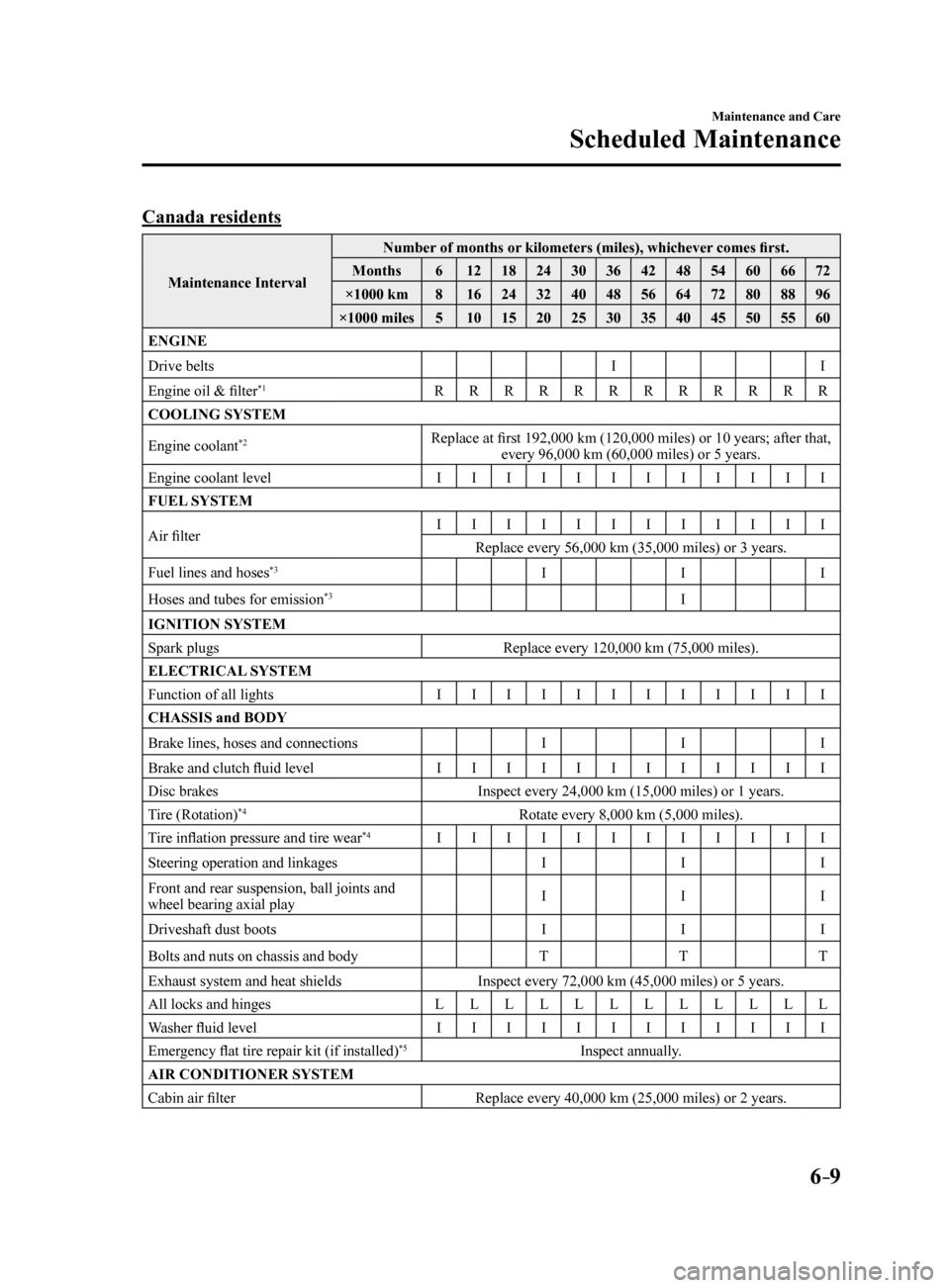
6–9
Maintenance and Care
Scheduled Maintenance
Canada residents
Maintenance IntervalNumber of months or kilometers (miles), whichever comes first.
Months 612 18243036424854606672
×1000 km 816 24324048566472808896
×1000 miles 510 15202530354045505560
ENGINE
Drive belts II
Engine oil & filter
*1R RRRRRRRRRRR
COOLING SYSTEM
Engine coolant
*2Replace at first 192,000 km (120,000 miles) or 10 years; after that, every 96,000 km (60,000 miles) or 5 years.
Engine coolant level IIIIIIIIIIII
FUEL SYSTEM
Air filter I
IIIIIIIIIII
Replace every 56,000 km (35,000 miles) or 3 years.
Fuel lines and hoses
*3I II
Hoses and tubes for emission
*3I
IGNITION SYSTEM
Spark plugs Replace every 120,000 km (75,000 miles).
ELECTRICAL SYSTEM
Function of all lights IIIIIIIIIIII
CHASSIS and BODY
Brake lines, hoses and connections III
Brake and clutch fluid level IIIIIIIIIIII
Disc brakes Inspect every 24,000 km (15,000 miles) or 1 years.
Tire (Rotation)
*4Rotate every 8,000 km (5,000 miles).
Tire inflation pressure and tire wear*4I IIIIIIIIIII
Steering operation and linkages III
Front and rear suspension, ball joints and
wheel bearing axial play I
II
Driveshaft dust boots III
Bolts and nuts on chassis and body TTT
Exhaust system and heat shields Inspect every 72,000 km (45,000 miles) or 5 years.
All locks and hinges LLLLLLLLLLLL
Washer fluid level IIIIIIIIIIII
Emergency flat tire repair kit (if installed)
*5Inspect annually.
AIR CONDITIONER SYSTEM
Cabin air filter Replace every 40,000 km (25,000 miles) or 2 years.
Mazda6_8FH2-EA-16F_Edition2.indb 92016/07/07 13:46:06
Page 398 of 578

6–12
Maintenance and Care
Scheduled Maintenance
Schedule 1
Maintenance IntervalNumber of months or kilometers, whichever comes first
Months 612 18243036424854606672
×1000 km 102030405060708090100 11 0120
ENGINE
Drive belts III
Engine oil & filter RRRRRRRRRRRR
COOLING SYSTEM
Cooling system III
Engine coolant
*1Replace at first 200,000 km or 10 years; after that, every 100,000 km or 5 years
FUEL SYSTEM
Air filter RRRRRR
Fuel lines and hoses I
*2I*2I
Hoses and tubes for emission I
*2I*2I
Fuel filter Replace every 60,000 km
IGNITION SYSTEM
Spark plugs I
IIIIIIIIIII
Replace every 120,000 km
CHASSIS and BODY
Brake lines, hoses and connections IIIIII
Brake and clutch fluid level III III III
Brake fluid RRR
Disc brakes IIIIIIIIIIII
Tire (Rotation)
*3Rotate every 10,000 km
Tire inflation pressure and tire wear*3I IIIIIIIIIII
Steering operation and linkages IIIIIIIIIIII
Front and rear suspension, ball joints and
wheel bearing axial play I
IIIII
Driveshaft dust boots IIIIII
Bolts and nuts on chassis and body TTTTTT
Exhaust system and heat shields IIIIII
All locks and hinges LLLLLLLLLLLL
Washer fluid level IIIIIIIIIIII
Emergency flat tire repair kit (if installed)
*4Inspect annually.
AIR CONDITIONER SYSTEM
Cabin air filter RRR
Mazda6_8FH2-EA-16F_Edition2.indb 122016/07/07 13:46:07
Page 400 of 578

6–14
Maintenance and Care
Scheduled Maintenance
Schedule 2
Maintenance IntervalNumber of months or kilometers, whichever comes first
Months 36912 1518212427303336
×1000 km 510 15202530354045505560
ENGINE
Drive belts I
Engine oil & filter RRRRRRRRRRRR
COOLING SYSTEM
Cooling system I
Engine coolant
*1Replace at first 200,000 km or 10 years; after that, every 100,000 km or 5 years
Engine coolant level IIIIIIIIIIII
FUEL SYSTEM
Air filter CRCRCR
Fuel lines and hoses I
*2
Hoses and tubes for emissionI*2
Fuel filterReplace every 60,000 km
IGNITION SYSTEM
Spark plugs I
IIIII
Replace every 120,000 km
ELECTRICAL SYSTEM
Function of all lights IIIIIIIIIIII
CHASSIS and BODY
Brake lines, hoses and connections III
Brake and clutch fluid level III II
Brake fluid R
Disc brakes IIIIII
Tire (Rotation)
*3Rotate every 10,000 km
Tire inflation pressure and tire wear
*3I IIIII
Steering operation and linkages IIIIII
Front and rear suspension, ball joints and
wheel bearing axial play I
II
Driveshaft dust boots III
Bolts and nuts on chassis and body TTT
Exhaust system and heat shields III
All locks and hinges LLLLLL
Washer fluid level IIIIII
Emergency flat tire repair kit (if installed)
*4Inspect annually.
Mazda6_8FH2-EA-16F_Edition2.indb 142016/07/07 13:46:07
Page 402 of 578
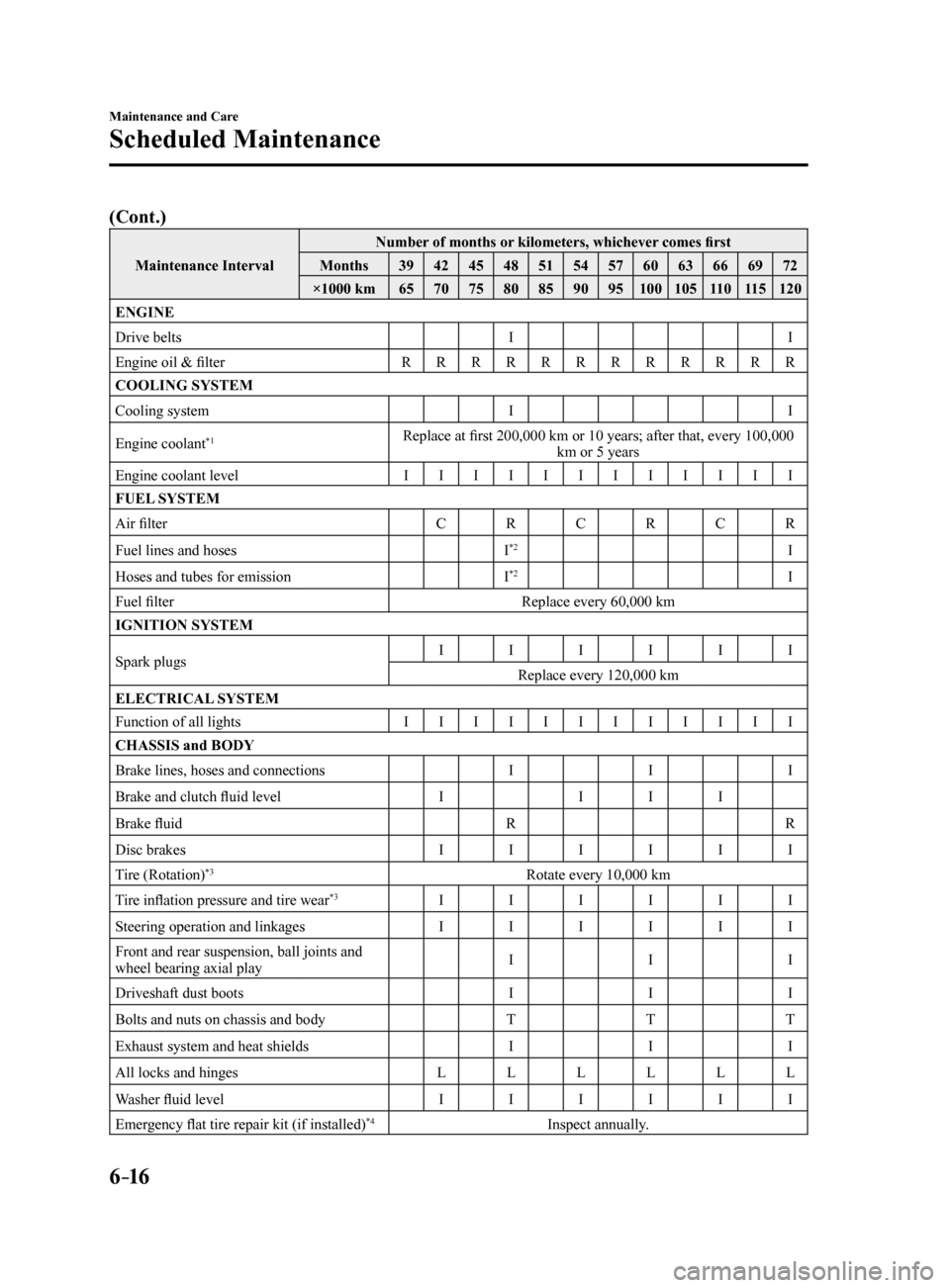
6–16
Maintenance and Care
Scheduled Maintenance
(Cont.)
Maintenance IntervalNumber of months or kilometers, whichever comes first
Months 394245485154576063666972
×1000 km 65707580859095100 105 11 011 5120
ENGINE
Drive belts II
Engine oil & filter RRRRRRRRRRRR
COOLING SYSTEM
Cooling system II
Engine coolant
*1Replace at first 200,000 km or 10 years; after that, every 100,000 km or 5 years
Engine coolant level IIIIIIIIIIII
FUEL SYSTEM
Air filter CRCRCR
Fuel lines and hoses I
*2I
Hoses and tubes for emission I
*2I
Fuel filter Replace every 60,000 km
IGNITION SYSTEM
Spark plugs I
IIIII
Replace every 120,000 km
ELECTRICAL SYSTEM
Function of all lights IIIIIIIIIIII
CHASSIS and BODY
Brake lines, hoses and connections III
Brake and clutch fluid level IIII
Brake fluid RR
Disc brakes IIIIII
Tire (Rotation)
*3Rotate every 10,000 km
Tire inflation pressure and tire wear
*3I IIIII
Steering operation and linkages IIIIII
Front and rear suspension, ball joints and
wheel bearing axial play I
II
Driveshaft dust boots III
Bolts and nuts on chassis and body TTT
Exhaust system and heat shields III
All locks and hinges LLLLLL
Washer fluid level IIIIII
Emergency flat tire repair kit (if installed)
*4Inspect annually.
Mazda6_8FH2-EA-16F_Edition2.indb 162016/07/07 13:46:07
Page 406 of 578
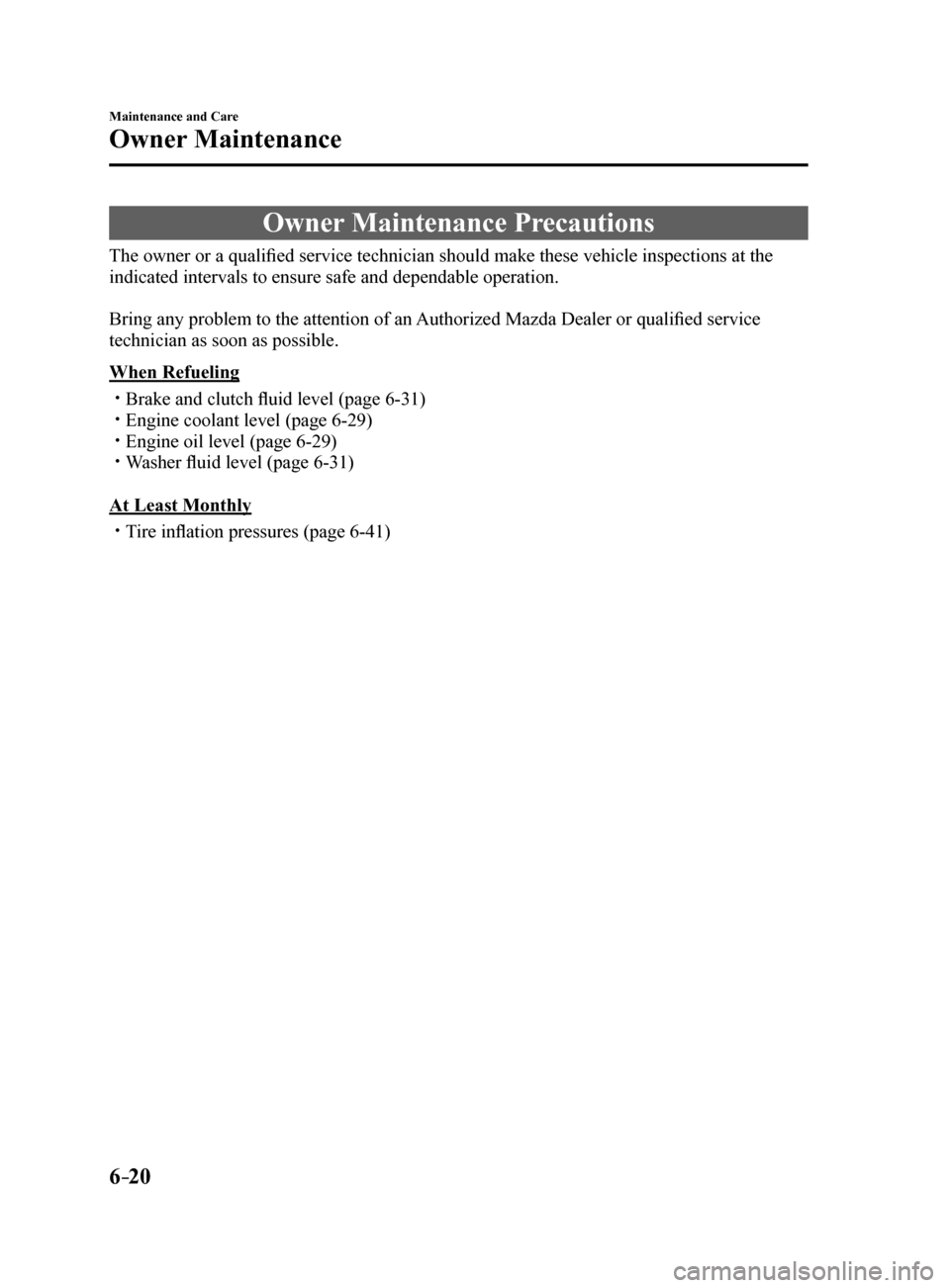
6–20
Maintenance and Care
Owner Maintenance
Owner Maintenance Precautions
The owner or a qualified service technician should make these vehicle inspections at the
indicated intervals to ensure safe and dependable operation.
Bring any problem to the attention of an Authorized Mazda Dealer or qualified service
technician as soon as possible.
When Refueling
Brake and clutch fluid level (page 6-31) Engine coolant level (page 6-29) Engine oil level (page 6-29) Washer fluid level (page 6-31)
At Least Monthly
Tire inflation pressures (page 6-41)
Mazda6_8FH2-EA-16F_Edition2.indb 202016/07/07 13:46:07
Page 426 of 578
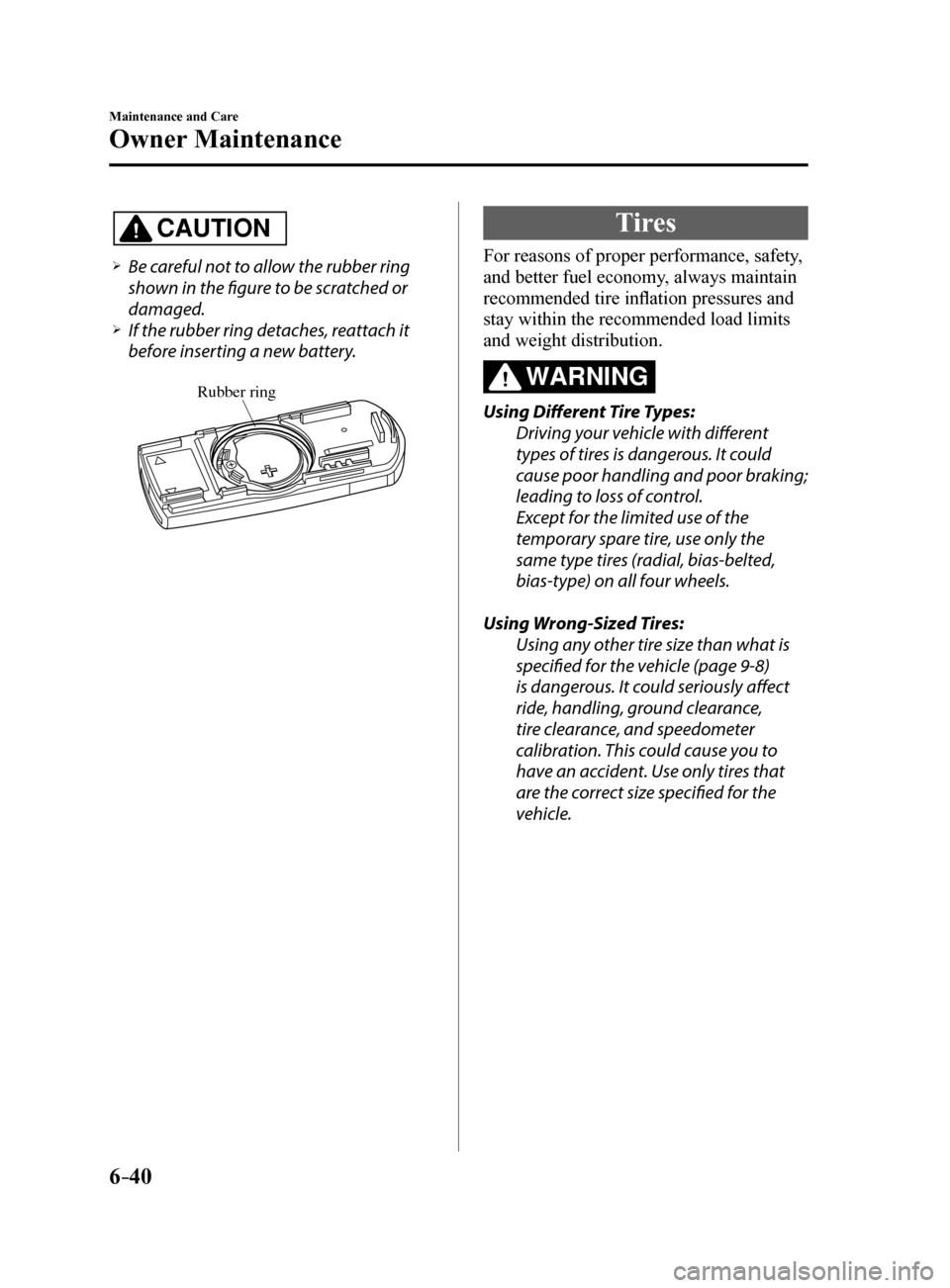
6–40
Maintenance and Care
Owner Maintenance
CAUTION
Be careful not to allow the rubber ring
shown in the figure to be scratched or
damaged.
If the rubber ring detaches, reattach it
before inserting a new battery.
Rubber ring
Tires
For reasons of proper performance, safety,
and better fuel economy, always maintain
recommended tire inflation pressures and
stay within the recommended load limits
and weight distribution.
WARNING
Using Different Tire Types:
Driving your vehicle with different
types of tires is dangerous. It could
cause poor handling and poor braking;
leading to loss of control.
Except for the limited use of the
temporary spare tire, use only the
same type tires (radial, bias-belted,
bias-type) on all four wheels.
Using Wrong-Sized Tires: Using any other tire size than what is
specified for the vehicle (page 9-8)
is dangerous. It could seriously affect
ride, handling, ground clearance,
tire clearance, and speedometer
calibration. This could cause you to
have an accident. Use only tires that
are the correct size specified for the
vehicle.
Mazda6_8FH2-EA-16F_Edition2.indb 402016/07/07 13:46:14